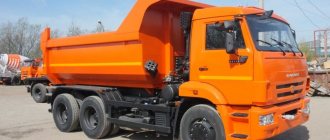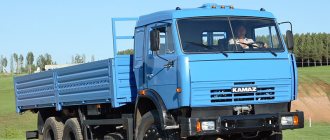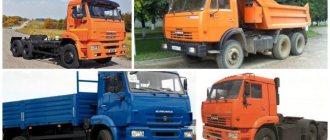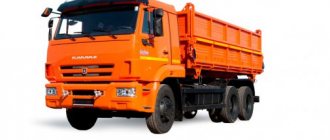In 1964, the Likhachev plant updated the line, and a new series of ZIL 130 appeared, which subsequently spread throughout the country. The car came in a huge number of modifications and was used everywhere.
In 1986, with the introduction of OST 37.001.269-83, the name of the model changed. The onboard version began to be produced under the designation ZIL 431410, the chassis - under the designation ZIL 431412. The new product was structurally different from its predecessor. The equipment received an improved 5-speed transmission, a redesigned suspension and a modernized 150-horsepower engine. The changes allowed the model to maintain its popularity among consumers, and ZIL 431412 became the main chassis for most specialized vehicles.
It is noteworthy that the series, which received its name from the Likhachev plant, was almost never assembled there. At that time, the principle of creating additional equipment at other factories was used, therefore, after the design was approved, the car left the main plant, where only the frame and cabin were produced for it. Subsequently, production of ZIL 431412 was opened at the Likhachev plant, where it continued until 1994. At the Ural Automotive Plant, this series was produced with the front part of the ZIL 131. Here the car was removed from the assembly line only in 2014.
Modifications
ZIL 431412 was used as a base for a huge number of vehicles. The following were based on this chassis:
- truck cranes ABK-4, KBA-22-15, KS 2561K and AKBS-4;
- aerial platforms and hydraulic lifts;
- special equipment with booths for emergency services;
- onboard models;
- fuel tankers;
- tank trucks for transporting milk, water, fuel and other liquids;
- dump trucks;
- watering machines;
- PRM mobile workshops;
- asphalt spreaders;
- equipment with tower-boom equipment ABKS-4 and ABK-4.
A little history
In 1984, the management of the Plant named after. Likhachev decided to modernize the model range. At this time, the ZIL-130 was replaced by two new car models:
- ZIL-431410 – onboard tractor;
- ZIL-431412 – chassis without body.
The hood and exterior design remain the same. But the internal components and mechanisms have undergone improvements, which are reflected in the technical characteristics of the cars.
Specifications
Dimensions:
- length – 6980 mm;
- width – 2500 mm;
- height – 2525 mm;
- wheelbase – 3800 mm;
- overall turning radius – 8900 mm.
Curb weight – 4175 kg. The load on the front axle was 2005 kg, on the rear axle – 2170 kg. The total weight of the vehicle was 10,400, the load capacity was up to 6,800 kg. The load on the front axle at full weight is 2510 kg, on the rear axle – 7890 kg.
The car accelerated to 60 km/h in 37 seconds, the top speed reached 90 km/h. At a speed of 50 km/h, the braking distance was 25 m, the run-out from 50 km/h was 750 m. The maximum climbability was 31 degrees.
ZIL 431412 was unpretentious. The car could operate on any surface at temperatures from -40 to +40 degrees.
Operational characteristics of ZIL-431412
In a short period of time, several tens of thousands of specialized vehicles came off the plant’s assembly line based on the ZIL-431412 chassis. These include:
Watering machine AKPM-3 on ZIL-431412 chassis
- truck cranes and aerial platforms;
- vehicles equipped with hydraulic lifting mechanisms;
- flatbed trucks and dump trucks;
- tankers used for transporting various liquids (water, milk, fuel, etc.);
- fuel tankers;
- watering and washing machines;
- asphalt spreaders;
- emergency vehicles with booths;
- mobile repair shops.
The performance of the car has improved thanks to a new, more powerful engine. The maneuverability of the vehicle has also increased. This was facilitated by an updated five-speed gearbox. Its feature is four gears that are synchronized with each other.
Engine
The ZIL 431412 was equipped with a time-tested 4-stroke gasoline unit ZIL-508.10 of its own production. The engine had a 2-chamber carburetor with an inertial oil filter, complemented by a 2-stage air cleaning, falling mixture flow and a forced idle economizer.
Design features:
- cast iron cylinder block with rubber seals and easily removable insert liners;
- aluminum pistons;
- mixed lubrication system (pressure, splash);
- forced crankcase ventilation;
- closed liquid cooling system.
Characteristics of the ZIL-508.10 engine:
- working volume – 6 l;
- rated power - 110.4 (150) kW (hp);
- maximum torque – 402 Nm;
- compression ratio – 6.5;
- number of cylinders – 8 (V-shaped arrangement);
- cylinder diameter – 100 mm;
- specific fuel consumption – 313 (230) g/kW per hour (g/hp per hour).
The ZIL 341412 fuel tank could hold up to 170 liters of fuel. Taking into account the average fuel consumption at a speed of 60 km/h (25.8 l/100 km), one refueling was enough for 650-680 km of travel.
Special vehicles produced on the basis of the ZIL-431412 chassis
A loading platform and additional equipment can be installed on the ZIL-431412 chassis. Machines with installed additional equipment are designed to perform specialized tasks.
Truck crane . There are several types of truck cranes installed on the ZIL chassis. But the most widespread is the KS2561K. It is small in size and easy to maintain. The crane is equipped with a lattice boom, the length of which is 8 meters. When using a special insert, the boom length increases to 12 meters.
KS2561K
Aerial platform . Aerial platforms for ZIL vehicles were developed and produced in Ukraine. They are made in the form of a two-armed boom with a cradle. The boom is lifted by a hydraulic mechanism. The reach of the cradle is 10.5 m, and the maximum height is 22 m.
AGP-22 aerial platform on ZIL 431412 chassis
Watering machine . Such vehicles are in demand in the road and public utilities sector. They are used for watering plantings, washing and cleaning roads, and wetting building materials. In addition to the tank itself, watering machines are equipped with additional equipment, selected depending on the type of work performed.
Watering machine KO-829 on ZIL-431412 chassis
Asphalt distributor . Asphalt distributors based on ZIL-431412 are designed for the delivery and distribution of lubricants (bitumen, fuel oil, oils, etc.). Installing a bitumen pump allows this work to be done.
Asphalt distributor on ZIL-431412 chassis
Device
The wheelbase of the ZIL 341412 did not change in comparison with its predecessor (4 to 2), which made it possible to use the vehicle on unpaved surfaces in areas where there were no roads at all. High cross-country ability was achieved thanks to the installation of wheels with automatic tire pressure adjustment.
On later modifications of the ZIL 341412, a reinforced frame was installed, making the structure resistant to increased loads. The change made it possible to mount heavy superstructures and transport larger loads. The type of suspension has not changed. The equipment was equipped with front and rear suspension on semi-elliptical springs with sliding rear ends. The front suspension also received shock absorbers.
ZIL 341412 was equipped with an improved 5-speed transmission (5 forward speeds, 1 reverse speed) with 4 synchronized gears, increasing the maneuverability of the vehicle. The gear shift was smooth. The transmission included a single-plate clutch with a mechanical drive and peripheral pressure springs.
The car used 3 brake systems that were independent of each other. The main system used a 2-circuit pneumatic drive, brake chambers equipped with spring accumulators and a brake force regulator. Braking was carried out using drum mechanisms. The spare brake system was combined with a parking brake with spring accumulators and a pneumatic drive. A separate single or 2-wire drive was provided for the road train trailer.
The ZIL 341412 cabin is all-metal and is designed according to a front-mounted hood (located behind the engine). The cabin is quite spacious. There is no sleeping space in the cabin. Inside there is a sofa with 3 seats. The driver's seat can be adjusted in height, back and forth. The salon has a heating system and ventilation, which allows you to work in the cold season and in the heat. The steering mechanism is made in the form of a rack with a toothed bipod. The basic version is equipped with power steering, which makes turning easier.
ZIL 341412 is used as a chassis for various superstructures. A wooden platform with folding side and rear sides and metal cross bars can be installed as a body. Additionally, extension sides are offered that increase the volume of the body, and an awning with a frame that protects from precipitation.
Municipal equipment, winter version. PM-130 from ALF | Topic author: Aliyah
The original was taken from stevelar in Municipal equipment, winter version.
PM-130 from ALF Carrying out street cleaning work is one of the most important tasks assigned to public utility organizations.
In order to maintain a populated area in proper condition throughout the year, it is necessary to clear roads of dirt, snow, and debris. To minimize the amount of manual labor involved and increase overall efficiency, it is best to use a sprinkler. Watering machine based on ZIL-130
Watering machine, created on the basis of ZIL-130, has a wide range of applications.
This variation of specialized equipment is used to moisten and wash roads and sidewalks with different surface qualities. By using this model, green spaces can be watered and even fires can be extinguished. The ability to install additional equipment expands the functional potential of the machine. In the winter season, the machine is transformed into a snow removal technique. For these purposes, a blade is installed in the front of the vehicle. This installation allows you to move snow drifts from the main road to the side of the road. At the same time, the brush that follows ensures the highest quality cleaning of the asphalt surface. If necessary, the watering machine can be equipped with special equipment designed for spreading the reagent. This happens to combat ice. There are a sufficient number of variations of watering machines on the market, but the model created on the basis of the ZIL-130 managed to achieve the greatest popularity. This trend is due to the design versatility and wide functional potential of the vehicle. Compared to competitive models, this machine stands out due to the presence of a special system that allows you to remove residual sand from the body without using the built-in spreading disc. In addition, you should pay attention to the option of adjusting the width of the road surface. In case of fire extinguishing, the watering machine acts as a water carrier. In this way, you can achieve more effective results in the fight against fire. Installation of additional equipment allows you to collect water from reservoirs. Additionally, the watering machine can clean storm drains. Device
The ZIL-130 watering machine is equipped with a tank for transporting water, which has the form of an oval-shaped welded structure.
A special filter, pipe, sump and central valve are installed inside it. The presence of two breakwaters in the central part of the tank prevents the water from pumping during movement. The maximum capacity of the container is kept at 5000 liters. If necessary, this figure can be increased by 1000 liters by installing a special extension. The central valve has a cylindrical shell, where two holes are located to retain a certain amount of water. This liquid is subsequently used to prime the water pump when drawing water from the reservoir. Thus, the central valve provides regulation of the water supply. The watering machine has two rotary nozzles. They consist of special crevice-type nozzles and a rotating device. You should also emphasize the use of a pump that is attached to the right side member of the vehicle through the use of a bracket and stepladders. The modification of the 130-B watering machine is additionally equipped with a fire hose with a barrel. This element is connected to the cross pipe. When the fire hose is running, all taps and valves for water supply must be tightly tightened. Model 130-P has an additional tank, presented in the form of a trailer. Its presence helps to increase the volume of transported water by 5000 liters. This tank is equipped with a sump and a plug valve. An eight-cylinder engine capable of producing 150 horsepower is used as a component of the power plant. This engine is combined with a five-speed gearbox, presented in a mechanical version. Considering that the vehicle is based on the ZIL-130, it has a dependent suspension on longitudinal springs. Double-acting hydraulic shock absorbers are installed in the front part, and additional springs are installed in the rear part. This design solution contributes to the most comfortable overcoming of the most problematic sections of the road with poor quality coverage. The presence of a hydraulic power steering mechanism facilitates the steering process. The brake system is drum-type. The additional installation of a pneumatic drive improves the quality of functioning of the entire brake assembly. The vehicle's gas tank is located on the left side member of the frame, and a pump is installed on the right. The machine has a closed power plant cooling system, which has the option of forced circulation of coolant. This is done through the use of a centrifugal water pump, which improves engine performance during operation. Operating principle
During operation, the water in the tank enters the inlet of a centrifugal pump.
The liquid first passes through a water filter and a central valve. Subsequently, the pump directs the incoming water through the pipeline to the nozzles. The pressure water supply is equipped with two outlets to the valve, which are located in the side part. Fire hydrants are connected through these holes. In this case, the pump pumps out liquid through a central valve and a strainer. Water is supplied to the main water pipe, and from there to the nozzles. The operation of the central valve is adjusted using a hydraulic cylinder. If necessary, the operator can change the angle of rotation of the nozzle used. The operation of the watering machine in fire-fighting mode requires the operator to first connect the fire hose to the pipeline outlet. All other valves and taps must be tightly tightened. Otherwise, the necessary pressure will not be created. The power take-off for driving the working parts is carried out through the use of a transfer case from a component of the base chassis installation. In this case, the required torque is transmitted to the gear pump of the vehicle’s hydraulic drive. Additionally, transmission is also made to the brush drive and the water pump, which provides water supply. The brush, which is used to remove debris, is located in the central part of the machine - between the front and rear axles of the wheels. In relation to them, the brush is installed with a slope of 28 degrees. The design features of the vehicle allow you to fill an empty tank in various ways. It is quite possible to get by with a connected hose and fill the container from a nearby body of water. The main function of collecting liquid here is performed by a special water pump. It is also possible to fill the tank using a hydrant. An alternative way to resolve the problem is through the top hatch at a specialized gas station. Technical characteristics
All operating processes of watering equipment are controlled from the driver’s cabin.
The presence of a multistage pump allows you to maintain the pressure inside the tank at a level of 25 atmospheres. Thanks to this, it is possible to simultaneously supply liquid to several consumers at once. As a result, with minimal water consumption, the quality of road surface cleaning increases many times over. The watering machine based on ZIL-130 is equipped with a capacious water tank, as a result of which you can easily clean a large area without additional liquid. If necessary, you can resort to using a trailed version of the tank. This will almost double the initial volume. The high level of power of the machine is achieved thanks to a power plant capable of producing 150 hp. The six-liter engine boasts maximum torque and maximum fuel efficiency. To cover a distance equivalent to one hundred kilometers, the ZIL-130 watering machine will spend 32 liters of fuel. Standard high-quality tires provide good grip on the road surface, minimizing the likelihood of getting into an accident. This machine is equipped with a whole range of active and passive safety systems. Technical characteristics of a watering machine based on ZIL-130:
Characteristics Indicators Dimensions, mm: - length 8900 - width 3070 - height 3000 Weight, kg 11200 Width of the working area, mm: - when watering 2000-2500 - when sweeping 2500 - when clearing snow 2500 Volume water tanks, m3 0.4-6 Tank volume, l 175 Engine: - volume, l 6 - power, hp 150 — power, kW 110 — V8 configuration — number of cylinders 8 — maximum torque, Nm 402 Fuel consumption, l/100 km 32 Cooling type liquid Power system two-chamber carburetor Manual transmission (5) The watering machine package includes: blade, brush for cleaning hard road surfaces from dust and debris; trailed tank (for modification 130-P). Trying to buy as many ALF models as possible at the initial stage of collecting (and I still like them now), and also knowing that the PM-130 models in summer/winter versions are quite difficult to find, I, among others, bought this particular machine . It was packaged with the previously shown ZIL-133G1 and ATs-2,6-53 from the same company and a similar ZIL-138 from Pegas-Models. About half of the models in the package were damaged and later restored. After a fairly long break, I will continue to show cars from my collection.
Initially - general front view:
The model, like all other ZILs from ALF, has wire wipers. They look quite delicate. The “flashing light” is quite normal. The outside rear view mirrors are also made of wire. The additional lighting lantern (it slipped my mind, as it’s called) could have been designed a little more elegantly, but even so it looks quite up to par. The dust that had accumulated on the machine could not be cleaned. Please excuse me:
The direction indicators, as on all models of the office of this family, are painted with orange paint. The lattice, in the same way, is through:
General view from above:
View from the left in profile in the direction of travel:
During the restoration of the model, the blade mounting system, namely the chain, was replaced, and the cylinders were painted. At first I was against making changes to the original. But I think it turned out better. Previously, the chain simply hung from the jib, and the blade and the model generally existed separately from each other. The chain was gray and thicker, there were no springs in sight:
Front wheel. I can say that I like the unobtrusive tread pattern. In contrast to the relief of the same SSM and DIP, which look overly pronounced for this scale:
The interior is not bad, but the one-piece sofa from ZIL-164 does not correspond to the original:
The neck, hatch and handles on the tank are made well: Gas tank, step, tap: Rear wheel: The rear optics are not divided into colored sections.
The decal is glued a little crookedly. But you can look at the tread pattern on the spare wheel: I have almost nothing to put next to the PM-130. Let that one be the basic ZIL-130: PM-130 from ALF and ZIL-130 from ALF: Right view: The decal indicating the city, even when enlarged, does not stand out much in outline. The handles, as usual, they didn’t want to make into separate parts: The cleaning brush (probably made from some kind of brush), looks a little rough in scale: Pencil cases with small things: And a drawer in the back: Bottom view: The spare wheel without fastening looks simply glued to the frame: Here you can see the wheels on which the blade originally stood near the machine: It would be great if the blade also turned in this place. But no: The individual number of my copy from the limited edition, as well as the mark of the master Sergei: Three quarters on top: PS: this is what a standard box looks like ALF: And symbols: But in this form the model came to me after sending it by our mail (to the right of hatch on the handle you can see the original chain for hanging the blade): Once again: PPS: for the help in restoring this model I would like to say a huge thank you to A.A. Granin. Car model: PM-130 Prototype production period: - Manufacturer: ALF Release date: - Brief opinion: the first utility vehicle in the collection... Rating: Quality: 5 out of 5. Assembly is normal. Detail: 6.5 out of 7. The detail of the model, as for me, is quite up to par. There is no etching - minus 0.25, however, everything not etched is made with wire or non-damaging means of suitable scale, which is normal for a model in this price category of technology of those years. Optics: -0.25 for being partially painted and the rear being a solid piece of orange plastic. Total: 6.5. Compliance with the prototype: 4 out of 5. Sofa in the cabin, and in general. Recognition: 2 out of 2. Similar. Probably... Charisma: 4.5 out of 5. It would be better with numbers. Box: 0.5 points out of 1.75.
In accordance with the gradation
. Total: 22.5 out of 24.75. Weight: 145 grams. Easy . Price: 6500 rubles.
I think I overpaid, since I saw a summer version of the same tank from the same manufacturer for 3,800 rubles. Tags: Aerial platform ARN 22 technical characteristics based on ZIL 130 and its weight











